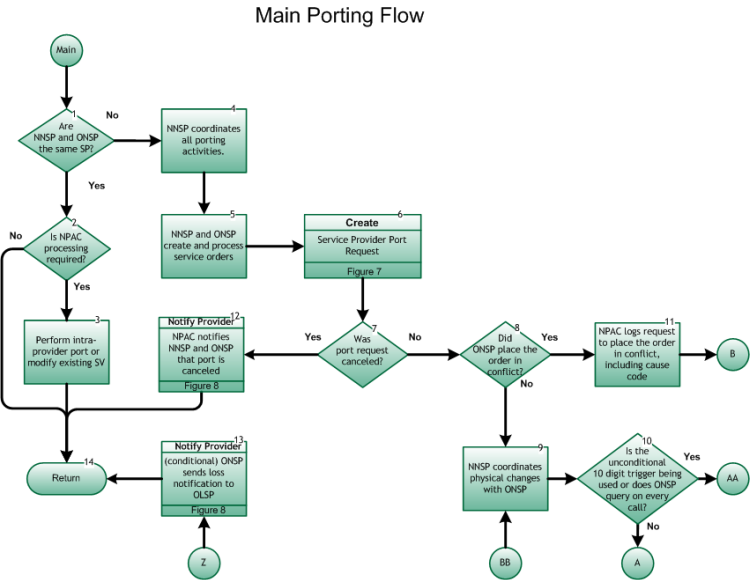Step 1: Are NNSP and ONSP the same SP?
- If Yes, go to Step 2.
- If No, go to Step 4.
Step 2: Is NPAC processing required?
- If Yes, go to Step 3.
- If No, go to Step14.
Step 3: Perform intra-provider port or modify existing SV
Step 4: NNSP coordinates all porting activities
- The NNSP must coordinate porting timeframes with the ONSP, and both provide appropriate messages to the NPAC. Upon completion of the LSR/FOC or ICP Process, and when ready to initiate service orders, go to Step 5.
Step 5: NNSP and ONSP create and process service orders
- Upon completion of the LSR/FOC or ICP Process, the NNSP and ONSP create and process service orders through their internal service order systems, based on information provided in the LSR/FOC or WPR/WPRR.
Step 6: Create – Service Provider Port Request
Step 7: Was port request canceled?
- The port can be canceled by the ONSP, the NNSP, or automatically by an NPAC process.
- If Yes, go to Step 12.
- If No, go to Step 8.
Step 8: Did ONSP place the order in Conflict?
-
Check Concurrence Flag.
If concurred, the ONSP agrees to the port.
If not concurred, a conflict cause code as defined in the FRS, is designated. ONSP makes a concerted effort to contact NNSP prior to placing SV in conflict.
- For wireline Simple Ports, the conflict request can be initiated up to the later of a.) the tunable time (Simple Port Conflict Restriction Window, current value of 9:00pm in the predominate time zone of the NPAC region where the number is being ported) one Business Day before the Due Date or b.) the T2 Timer (Final Concurrence Window tunable parameter) has expired.
- For wireline Non-Simple Ports, the conflict request can be initiated up to the later of a.) the tunable time (Conflict Restriction Window, current value of 12:00pm) one Business Day before the Due Date or b.) the T2 Timer (Final Concurrence Window tunable parameter) has expired.
- For wireless SPs using short timers for this SV, the conflict request is not restricted and can be initiated up to the time the port is activated.
- If Yes, go to Step 11.
- If No, go to Step 9.
Step 9: NNSP coordinates physical changes with ONSP
- The NNSP has the option of requesting a coordinated order. This is also the re-entry point from the Inter-Service Provider LNP Operations Flows – Conflict Flow for the Service Creation Provisioning Process, tie point BB, Figure 11.
- If coordination is requested on the LSR, an indication of Yes or No for the application of a 10-digit trigger is required. If No coordination indication is given, then by default, the 10-digit trigger is applied if technically feasible. If the NNSP requests a coordinated order and specifies ‘No’ on the application of the 10-digit trigger, the ONSP uses the 10-digit trigger at its discretion.
Step 10: Is the unconditional 10 digit trigger being used or does ONSP query on every call?
- The unconditional 10-digit trigger is assigned to a number on a donor switch during the transition period when the number is physically moved from donor switch to recipient switch. During this period it is possible for the TN to reside in both donor and recipient switches at the same time.
- For both Simple and Non-Simple Ports, the ONSP must deploy the 10-digit trigger in the donor switch, if technically feasible, or monitor the NPAC for activation in order to trigger the disconnect, or carriers perform a database query for every call origination.A 10-digit trigger is applied by the ONSP no later than 11:59pm the day prior to the due date.
- The unconditional 10-digit trigger may be applied by the NNSP.
- If Yes, go to Inter-Service Provider LNP Operations Flows - Provisioning with Unconditional 10-Digit Trigger - tie point AA, Figure 10
.
- If No, go to Inter-Service Provider LNP Operations Flows - Provisioning without Unconditional 10-digit Trigger - tie point A, Figure 9.
Step 11: NPAC logs request to place the order in conflict, including cause code
Step 12: Notify Provider – NPAC notifies NNSP and ONSP that port is canceled
- Upon cancellation, NPAC logs this information, and changes the subscription status to canceled
. Both SPs are notified of the change in the subscription status via the SOA interface.
- For the notification process, refer to Inter-Service Provider LNP Operations Flows – Reseller/Interconnected VoIP Provider/Type 1 Notification, Figure 8
.
- Both SPs take appropriate action related to internal work orders.

